Interactive video installation
casting: Marie Andre, Hicter Anicee, Geska Helena Andersson, Robert Brečević, Andrew Brouse, Jordan Delphine, Anne D'hond, Laurence D'hond, Laurent d'Ursel, Nicolas Kozakis, Boris Lehman, Lot Lemm, Nicolas Leroy, Petko Ognyanov, Daniel Piaggio-Strandluno, Jose Luis Macos Paredes, Kurt Ryslavy, Vera Smirnova, Simon de Wrangel
programming: Bart Vandeput
light: Julie Swennen
photo assistant: Stefan Piat
production: Vlaams Gemeenschap - www.kunstenerfgoed.be
co-production: Nadine vzw - www.nadine.be
Adem vzw
video
ARCHIVE photos - FILE 2009
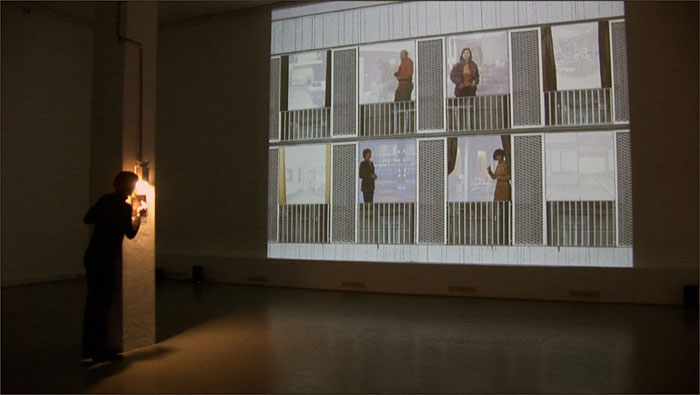
Short resume:
“Drama house” is based on chance and the choices that viewers make, the project explores the contemporary trends in the construction of a narrative and the interplay between diverse informative sub-layers effected through the impact of digital, non-linear media. It also questions the very process of story telling and at the same time considers the way of audience reading. It investigates the differences of individual and collective perception. In other words, the sequence and choices that each viewer selects reflect his own perspectives and behavioral patterns, thus makes the viewer much more than an active participant.
 .
.
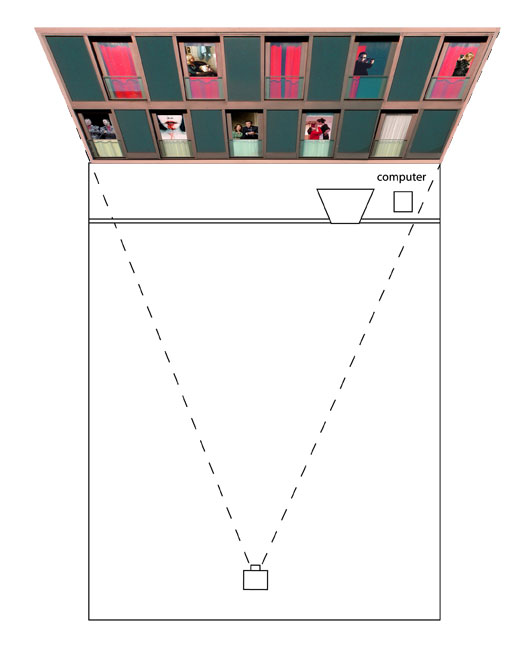 |
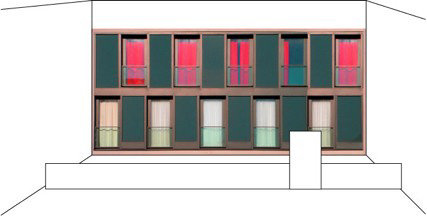 |
“Chance is the greatest romancer in the world,” from 'Avant-propos' to ‘La Comedie Humaine’
By Honore de Balzac
The installation idea is loosely based on the H. de Balzac ‘Human Comedy’. Like the French realist I wanted to create a panoramic view of contemporary society.
Drama-House narrative is a collection of 8 linked short stories placed in a variety of settings, with characters appearing in the windows in response to a bell ring.
The project’s setting is in a contemporary city, with its habitants: new wealth, middle-class, professionals, servants, intellectuals, immigrants, demi-monde and criminals. For this social mosaic the artist choice of characters ranges from literature (de Balzac ‘Human Comedy’, Perec Life: A User's Manual and etc). These characters quickly disclose their base, self-serving natures through films, none of them lasting more than 2 minutes.
Like in Alfred Hitchcock's classic Rear Window, the bright windows of the DH are both confined and multileveled: its stories and visual perspective are dictated by the interaction of the protagonist's confinement in his/her apartment and the participant choice and position from which both he and the audience glimpse on the lives of the various tenants. Cheerful voyeurism affords a droll comic atmosphere that suddenly darkens when one sees clues to what may become violence.
The spectator’s involvement in the resident’s drama/comedy visible from his position is a by-product of both boredom and natural human curiosity. Video-artist is, in fact, a voyeur by trade: the stories are a mere pretext for the artist who is more interested in the implications of viewer’s perspective. The audience actually learns more about the lives of the residents watching them undetected: phenomenon that provides the other vital thread to the script. While the artist offering herself as a visual storyteller, she makes audience accomplices to spying. At deeper levels, Drama House examines issues of moral responsibility and emotional honesty in regards to strangers.
Concept
Based on chance and the choices that viewers make, the project explores the contemporary trends in the construction of a narrative and the interplay between diverse informative sub-layers effected through the impact of digital, non-linear media. It also questions the very process of story telling and at the same time considers the way of audience reading. It investigates the differences of individual and collective perception. In other words, the sequence and choices that each viewer selects reflect his own perspectives and behavioral patterns, thus makes the viewer much more than an active participant.
By interacting with the installation the viewer is engaged in the creative process: re-telling the ever-changing story through the utilization of the primary capability of the digitization: reshaping the information. Therefore, each participant walks away with a unique, slightly different vision, each shaped according to his own choices and directions.
Interactive media and the digital environment of the DH and its narrative function through a recognizable metaphor that makes access to the information meaningful: a house as a conceptual society model and an apartment as a private space. This reference transforms the objects and stories in the project into the metaphors and reminds us of the art cultural function: as a site of memory of the social collective imagination and as a site of representation and power.
Drama house is an interactive multimedia installation with various members of its menagerie, which comes alive with the contributions of its users. The open infrastructure provides an opportunity for interactive simulation environment and visualizes technological approaches. The installation is an expanded mixed reality environment that uses a simple urban model as an example illustrating application possibilities. Visitors can manipulate the various scenarios with the bells.
The DH projects focus on a thematic domain at the nexus of art, technology and society. This media installation created especially for is an example of this triple encounter with a house as a point of departure. Private stories that actually take place within the house/ apartments structure are transformed into visualizations that populate the complex itself in the form of different people that react to visitors—for instance, timidly, politely encouraging or somewhat miffed.
The installation attempts to restage the spectator experience in a virtual environment. The project also explores the duality of life: a viewer finds himself performing a double role being simultaneously a director and a spectator.
Installation Description
The set for the Drama House consists a projection of a house’ façade of the 2-story building with 4 square windows on each floor. The non-linear index or narrative mimics short movies, video footage of home events in the form of 30 stories that have been arranged and staged at the windows in the 8 superimposed on its façade.
The story development depends on - how much spectator push one doorbell or - how many bells he push in the same time or - in what composition they were pushed (ex.: App 1- app2 – app 7 and etc).
A low fence with a door-gate separates the spectator form the house. Its door-gate is fashioned with 8 doorbells each corresponds to an apartment/ window.
A house is animated when a spectator ring a doorbell. One ring provokes an action in one window and can have unpredictable consequences, event, each is stranger then another.
The DH requires a semi-enclosed space minimum 10 x 8m, 8m x 4m wall painted white. The computer image is projected large scale on the wall allowing for larger audience access.
01. 1 computer MAC or PC with a monitor and a keyboard
a. Processor: -- Intel Core2-duo 2.4Ghz or 2.93Ghz; b. RAM -- 2Gb.; c. Hard-Drive -- not less than 100Gb. ; d. Video-Card -- ATI or NVidia; e. OS; Sound Card/Interface; h. 3 firewire entrance
02. 1 video projector not less then 5000 lum (pref. WIDE ANGLE)
03. 2 speakers with 1 amplifier (computer speakers)
04. Sport Midi 1x1
05. cable MIDI
06. Interface 8 digital entances Interface-Z
07. Buttons set
08. VGA cable 30 m
09. cable USB
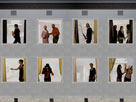 |
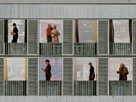 |
 |
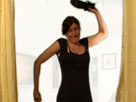 |
 |
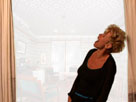 |
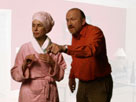 |
 |
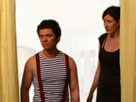 |
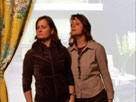 |
 |
 |
Het leven, een gebruiksaanwijzing
interactieve video installatie
“Le hasard est le plus grand romancier du monde,” uit 'Avant-propos de La Comédie Humaine’ door Honoré de Balzac
‘Het leven, een gebruiksaanwijzing’ is een versmelting van traditionele film, theater, literatuur en hedendaagse media.
Het idee voor de installatie is gebaseerd op de roman “La vie, mode d’emploi” (1978) van Georges Perec, dat zich volledig afspeelt in éénzelfde herenhuis met verschillende appartementen en bewoners. Net als de Franse schrijver wil ik een panoramisch beeld van de hedendaagse maatschappij schetsen.
De installatie ‘Het leven, een gebruiksaanwijzing’ is een verzameling van 30 onderling verbonden kortverhalen in diverse situaties, die door het publiek worden aangestuurd door aan een deurbel aan te bellen. Telkens men dit doet verschijnen er andere personages in verschillende situaties aan de verschillende vensters.
Het gegeven speelt zich af in een niet bepaalde hedendaagse stad, met haar middenklasse, nieuwe rijken, zelfstandigen, knechten, intellectuelen, immigranten, demi-monde en misdadigers die ik ontleen uit de roman(s) van Perec. De figuren die ik hieruit ontleen geven snel hun achtergrond en zelfvoldane natuur vrij door een reeks scènes, die nooit langer dan 2 minuten duren. De menselijke eigenschappen worden met veel zwarte humor en kwinkslagen beschreven.
Net als in de Hitchcock klassieker ‘Rear Window’ zijn de fel verlichte vensters in de installatie van ‘Het leven, een gebruiksaanwijzing’ zowel besloten als gelaagd: de verhalen en het visuele perspectief worden bepaald door de beslotenheid van de protagonist in zijn appartement en de keuze en plaats van de deelnemer, van waaruit hij en het publiek binnengluren in het leven van de verschillende bewoners. Vrolijk voyeurisme biedt een grappige komische sfeer die plots verduistert wanneer details worden waargenomen van hetgeen wel eens een moord zou kunnen zijn.
De onderdompeling van de toeschouwer in het menselijke drama/blijspel vanuit dit standpunt is een neveneffect van zowel verveling als natuurlijke menselijke nieuwsgierigheid. De videokunstenaar is, in feite, een beroepsvoyeur: de verhalen zijn slechts een voorwendsel voor de kunstenaar die meer geïnteresseerd is in de implicaties van het perspectief van de kijker/bewaker. Het publiek leert meer over het leven van de bewoners door ze ongemerkt gade te slaan. Terwijl de kunstenaar zichzelf aanbiedt als visuele verteller, maakt hij het publiek medeplichtig aan spionage. Op een dieper niveau onderzoekt ‘Het leven, een gebruiksaanwijzing’ morele verantwoordelijkheid en emotionele eerlijkheid in verhouding tot vreemden.
Concept
Gebaseerd op het toeval en op de keuzes van de toeschouwers onderzoekt het project de hedendaagse trends inzake verhaalconstructies en de interactie tussen verschillende informatieve onderlagen onderworpen aan digitale, niet lineaire media. Het stelt ook het vertelproces zelf in vraag. Het onderzoekt de verschillen tussen individuele en collectieve waarneming. In andere woorden, de volgorde en de keuzes van elke toeschouwer geeft een beeld van eigen zijn perspectief en gedrag. De toeschouwer wordt aldus veeleer gezien als een actieve deelnemer.
Door de interactie met de installatie gaat de toeschouwer deel uitmaken van het creatieve proces: het alsmaar veranderende verhaal hervertellend m.b.v. de primaire mogelijkheid van digitalisering: de informatie her-vormen. Op die manier gaat iedere toeschouwer weg met een uniek, ietwat verschillend verhaal, gevormd door zijn/haar eigen keuzes en richtingen.
‘Het leven, een gebruiksaanwijzing’ is een interactieve multimedia installatie met een gediversifieerde fauna, die tot leven komt door de bijdrage van de gebruikers. De open infrastructuur biedt een mogelijkheid tot een interactieve virtuele omgeving. De installatie is een uitgebreide mixed-reality omgeving en gebruikt een eenvoudig stedelijk model als een voorbeeld waarmee toepassingsmogelijkheden geïllustreerd worden. Bezoekers kunnen door aan te bellen de verschillende scenario's manipuleren.
Het Dream House project spitst zich toe op een thematisch gebied gelegen op het kruispunt tussen kunst, technologie en maatschappij. Deze media-installatie is bedoeld als een prototype van deze drieledige ontmoeting, met het huis als vertrekpunt. Privé-verhalen die plaatsvinden in de appartementen van het huis worden visualisaties die het complex zelf bevolken in de vorm van abstracte wezens die reageren op de bezoekers - bv. schuchter, beleefd aanmoedigend of ietwat geërgerd. Hoe langer een bezoeker in contact blijft met één van de bewoners hoe langer en intenser de emoties en bewegingen van de protagonist worden.
Het werk stelt de verhoudingen tussen het fysieke en het digitale, het virtuele en het reële in vraag. In dit samenspel creëert de toeschouwer unieke 'momenten', die vaak onvoorspelbaar en spontaan zijn, aangezien het 'tableau' ook een levende acteur/toeschouwer/participant inhoudt voor wie een bezoek aan het huis een feitelijke ontmoeting met de bewoners wordt.
Installatie omschrijving
Het decor voor ‘Het leven, een gebruiksaanwijzing’ bestaat uit een videoprojectie van de façade van een gebouw met twee verdiepingen die elk vijf grote ramen tellen.
De niet-lineaire index van het verhaal bestaat uit 30 aparte verhalen die geschikt en opgevoerd worden in de ramen van de 10 kamers van het huis. De deur is voorzien van 10 deurbellen, elk ervan overeenstemmend met één appartement/raam.
Een woning wordt geanimeerd als een toeschouwer een deurbel indrukt. Eén druk veroorzaakt een actie in één raam en kan onvoorspelbare gevolgen hebben, de ene al vreemder dan de andere. Al wat de bewoners overkomt maakt deel uit van het dagelijkse leven, ook al lijken de omstandigheden soms overdreven.
‘Het leven, een gebruiksaanwijzing’ vereist een half gesloten ruimte van minstens 10mx15m met witte muren. Het computerbeeld wordt in groot formaat geprojecteerd op de muur om zo de toegang voor een ruim publiek mogelijk te maken.